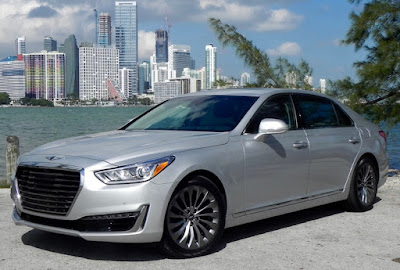IF YOU WANT PERFORMANCE FROM AN SUV, THE INFINITI QX50 OFFERS AN ANSWER
Shortly after the new year began, I had the opportunity to spend time in an Infiniti QX80 SUV, which I thought fit the description of a true “land yacht” as a colleague had dubbed the full-size conversion van I owned back in the mid-1980s and ’90s.
I concluded that although the QX80 was packed with a lot of felicitous features, it was a bit big for my tastes and needs. Driving such a large vehicle can be a chore in urban environs where streets can be narrow and many spaces in mall parking lots tend to be the size of a stick of chewing gum.
Door ding, anyone?
Too much bulk, however, is not an issue with the 2017 Infiniti QX50 I have been driving for the past week. As a small SUV introduced as the Infiniti EX35 nearly a decade ago, the QX50 is more sedan-like in its handling and performance than it is “land yacht,” much more of a driver’s car than its big brother.
Whereas the QX80 stretches out to nearly 209 inches long and weighs in at a hefty 5,644 pounds in 2WD and 5,888 with 4WD, the QX50 is almost two feet shorter at 186.8 inches and weighs in well under two tons with two-wheel drive (3,855 pounds) and just slightly over that with four-wheel drive (4,040 pounds).
With a naturally aspirated 3.7-liter V6 pumping out 325 horsepower at 7000 rpm and 267 pound-feet of torque at 5200, the QX50 responds quickly and assuredly when pressed. The website zeroto60times.com clocked at 5.6 seconds from zero-to-60 mph.
Mated with a seven-speed automatic transmission with a “sport” mode and manual gear selection capability, it delivers fuel economy at a rate of 17 miles-per-gallon city, 24 highway and 20 combined in either 2WD or 4WD configuration.
Of course, if performance is all you are interested in, you are not likely spending much time looking over SUVs in a showroom, no matter how sprightly they are. Maybe you need all the space and third-row seating the QX80 offers.
But if the weekly grocery haul and an occasional run to the local Home Depot or Lowe’s is about all the cargo needs you have, the QX50 may be your answer. It seats five, and the nearly seven inches of extra legroom they get over the 2015 model (up to 35.3 inches) is sure to make backseat riders less grumbling.
And here’s a rather surprising number. Cargo capacity in the QX50 is listed as 18.6 cubic feet behind the second row, which is actually more than the 16.6 cubic feet the QX80 offers behind its third.
Yes, you gain a bunch of stowage capability when the third-row seats in the QX80 are folded, but you can do the same with the QX50’s second row as well. I was able to handle a six-feet section of bamboo fencing quite easily in the QX50 by folding the right section of the second-row seats, an act accomplished , thanks to the optional Deluxe Package, by the push of a button on the right just inside the rear liftgate.
Infiniti has outfitted the QX50 with the kind of features suited to the luxury genre, including leather seats, eight-way power adjustable driver’s seat with lumbar support and four-way power passenger seat, moonroof with one-touch auto open/close, leather-wrapped steering wheel and shift knob, dual zone climate control with micro air filter, LED daytime running and fog lights, rearview camera, a center stack that is highlighted by Infiniti’s signature analog clock, Bluetooth phone connectivity, and a USB port.
That and more are included in the base MSRP of $34,450.
Optional features such as a Premium Package (upgraded sound system and advanced climate control, maple wood interior accents, etc.), Premium Plus Package (navigation, around-view monitor with front and rear sonar system to aid in parking), Deluxe Touring Package (19-inch, five-spoke aluminum allow wheels over 18-inchers, HID headlights in place of halogen lamps, power folding second row seats, etc.), and Technology Package (Intelligent Cruise Control, blind-spot and lane-departure warning, brake assist with frontal collision warning, and aluminum pedals) plus the destination and delivery fee but the final tab for my test vehicle to $43,735.
Even at that price the QX50 is still close to the bargain category in a segment that includes entrants from Porsche, Jaguar, Mercedes-Benz, and Audi.
What I liked about the 2017 Infiniti QX50: I found the few demands I asked of technological features easily handled. Infiniti has had the good sense to include knobs for such functions as surfing the radio dial. The ride is quiet and comfortable.
What I didn’t like about the 2017 Infiniti QX50: The fact that Infiniti hasn’t made significant changes to the QX50 since its debut as the EX doesn’t really bother me, but the company needs to smooth out some of the responses to voice commands. There is an extra step or two when it comes to tuning the radio, and when I asked to “call home,” I got a long list of numbers to choose from, none which was the number I have under “home” in my directory. My guess is that they were the “home” numbers to go with the names in the directory. Also, the fuel mileage is among the worst in its class. That eventually would take a toll as premium unleaded is recommended.
Would I buy the 2017 Infiniti QX50: Yes. It’s definitely should be on your list if you are shopping in this genre. It’s a good looking vehicle, a sprightly performer that also has a practical side, and could save you a few bucks in the deal.





























